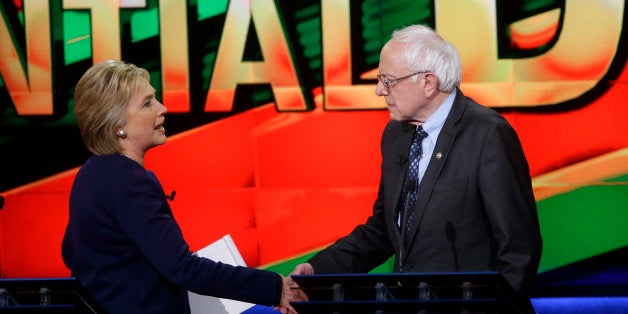
All POTUS campaigns are not the same. And it matters.
For example, Bernie Sanders' hashtag #notmeus and Trump's populist appeal both take on characteristics of social movements. Here, the campaign's emphasis is on group-level mobilization: voices unified in response to perceived injustices or lack of empowerment.
By contrast, Hillary Clinton's candidate-centric hashtag #Imwithher, Marco Rubio's emphasis on his personal "Marcomentum" before Super Tuesday, and John Kasich's appeal to his personal past experience and present maturity suggest that the candidate are offered as brands. The campaigns' focus is their candidate - not their supporters.
For branded campaigns, the candidate is the product. For movement campaigns, the candidate is the rallying cry.
This distinction is important, because the criteria for failure and success of movements and brands differ dramatically.
First, consider the way that movements work. They are sparked by injustice-based grievance. Since grievances are easy to find, the movement politician's primary task is to inspire a sense of efficacy - a feeling that the movement can create change. Powerful rhetoric prompts vacillation between grievance and hope, which in turn stokes the emotion critical to movements.
This is why detailed implementation plans are not critical to movement campaigns. In fact, if detailed plans appear complex, they would lower peoples' sense of efficacy. Hence, if Sanders or Trump were to belabor the finer points of the plans - however well- or ill-founded as they may be -then they may impede their movement rather than help it.
Second, calling a movement's goals unrealistic is meaningless. Movements intentionally drive toward outcomes that could not be real before the movement existed. Thus, economists' critiques of Sanders' economic proposals or pundits who mock Trump's Mexican Wall are missing the point: those proposals will become possible only when the movement gains power. As of yet, it's still on its way.
Third, individuals who support a movement do not define it; they simply become part of its tide. This means that missteps by a movement's surrogates or strange temporary alliances are less defining than pundits may claim. Indeed, the variation in the group validates the movement's grievances as widespread and real.
Perhaps most importantly, changes in a movement are understood as natural evolution, not a lack of reliability. History is irrelevant, particularly for new movements. This characteristic of movements explains Trump's invulnerability to flip-flop critiques- it is simple for him to explain that a.) his life before starting his movement is irrelevant, and b.) since much information is new to him, learning is to be expected.
And what makes a movement successful? Their contributions to public discourse may be their greatest legacy, and it helps if those contributions can be condensed to bite-size bits of shorthand. As the Sanders campaign has raised the profile of income inequality, and as the Trump campaign has spread the idea that America must be "made great again," both may be said to be succeeding - at least by a movement's standards.
On the other hand, a personal brand offers a completely different set of strengths and weaknesses.
First, unlike movements, people place high value in a brand's consistency over time. Branded candidates will struggle to distance themselves from their past. Brand-inconsistency is anathema: consider Whole Foods' recent "peeled orange" fiasco - the highly-packaged, waste-inducing product was so inconsistent with the Whole Foods brand that it caused massive uproar. If one week, John Kasich says he's OK with same-sex marriage, but the next says he isn't, well, who is this guy? Is he pandering? Can he be trusted?
Second, if a brand launches off toward a wild, unrealistic goal, it looks foolish. If Apple were to announce tomorrow that it was launching a new line of automobiles, then the market would push for an explanation. So laying out detailed plans toward goals is important, and perhaps the more technically-detailed the plan, the more expert the brand appears. Thus, Hillary Clinton's campaign needs smart, on-point plans in a way that the Sanders campaign doesn't - even for exactly the same proposal.
Third, brands are strongly-defined by the elements with which they align themselves. Brand alliances can drag or lift. For example, when Martha Stewart's star fell, so went K-Mart's hopes. This leads to trouble when our in-group deviates from our core message, as the Clinton campaign experienced in the case of Gloria Steinem and Madeline Albright's ill-advised commentary.
But personal brands have one major advantage over movements: Whereas the victories of a movement are diffuse and difficult to measure, the victories of a winning brand are unambiguous. Brands that win gain support, as individuals hope to bask in their reflected glory. This explains why Cruz may have overplayed his few wins over Trump in the last GOP debate. Yes, it was only a handful of wins, but by God, they were WINS. It also explains why Clinton's narrow-margin wins may be weighted heavily by her campaign, despite the proportional allocation of delegates. When brands win, it matters - no matter how or why.
Analyzing the campaigns this way raises important questions: Do different segments of voters tend to prefer movements over brands, or vice-versa? Can a movement voter be converted to a brand voter, which may be necessary as we move toward November? Can a failing brand campaign shift to movement language, as the Rubio campaign has done since Super Tuesday? Will voters adopt the grievance against Donald Trump that could fuel a countermovement, even given the absence of clear, decisive "wins?"
In the meantime, perhaps we should acknowledge that these candidacies have different contributions to make to democracy. Doing so may allow, at least in some sense, a step toward hope that, despite this election cycle's apparent chaos, democracy continues to progress via both movements and brands.